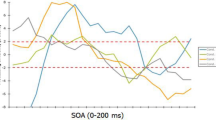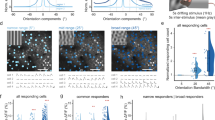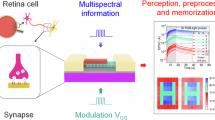Abstract
ANY spatial distribution of luminance can be considered as the sum of its sinusoidal Fourier components, which are defined when their amplitudes and phases are given. Recently Fourier theory has been applied in describing the transmission of spatial information in the visual system. Indeed neurones selectively sensitive to a narrow band of spatial frequencies have been found in the visual cortex of the cat and monkey1,2. With psychophysical methods, using an adaptation effect, spatial frequency channels have been observed also in the visual system of man3,4.
This is a preview of subscription content, access via your institution
Access options
Subscribe to this journal
Receive 51 print issues and online access
$199.00 per year
only $3.90 per issue
Buy this article
- Purchase on SpringerLink
- Instant access to full article PDF
Prices may be subject to local taxes which are calculated during checkout
Similar content being viewed by others
References
Campbell, F. W., Cooper, G. F., Robson, J. G., and Sachs, M. B., J. Physiol., 204, 120 (1969).
Campbell, F. W., Cooper, G. F., and Enroth-Cugell, Christina, J. Physiol., 203, 223 (1969).
Blakemore, C., and Campbell, F. W., J. Physiol., 203, 237 (1969).
Campbell, F. W., and Maffei, L., J. Physiol., 207, 635 (1970).
Levelt, W. J. M., On Binocular Rivalry (Mouton, The Hague, 1968).
Author information
Authors and Affiliations
Rights and permissions
About this article
Cite this article
MAFFEI, L., FIORENTINI, A. Processes of Synthesis in Visual Perception. Nature 240, 479–481 (1972). https://doi.org/10.1038/240479a0
Received:
Issue date:
DOI: https://doi.org/10.1038/240479a0
This article is cited by
-
Contrast summation in dichoptic vision
Psychological Research (1983)
-
Reconstruction of spatial information in the human visual system
Nature (1982)
-
Recent advances in electrical recording from the human brain
Nature (1975)
-
Visual analysis in unspecialized receptive fields as an orthogonal series expansion
Neurophysiology (1975)



